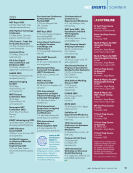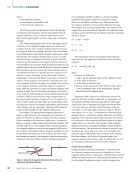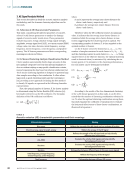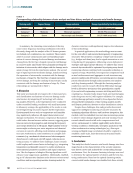LEARNING FROM
THE LIGHT: CIVIL
ENGINEERING
STUDENTS MONITOR
150-YEAR-OLD
LIGHTHOUSE
A group of 10 graduate students from the University
of Wisconsin–Madison’s civil and environmental
engineering program is monitoring the structural
health of the 150-year-old Au Sable Lighthouse. Led
by Jesse Hampton, an assistant professor of civil
and environmental engineering, the students are
studying this historic structure located in Michigan’s
Upper Peninsula at the Pictured Rocks National
Lakeshore. The lighthouse, constructed in 1874, is
part of the Au Sable Light Station, which was built by
the US Lighthouse Service and later managed by the
US Coast Guard.
In collaboration with the US Army Engineer
Research and Development Center’s Construction
Engineering Research Laboratory (ERDC-CERL)
and the National Park Service, Hampton’s team has
instrumented the lighthouse using fiber-optic cables
wound around the central stairway.
“With fiber-optic sensing, we can monitor
high-frequency and low-frequency deforma-
tions,” Hampton said. “Low frequency could be,
for example, if there’s any cantilever beam action
from the wind or a big storm pushing against the
structure. High frequency could be any sort of vibra-
tion from the ground or people moving through the
building.”
Nathan Opperman and Gowshikan Arulananthan
are two geological engineering PhD students in
Hampton’s research group. Opperman says the
monitoring system yielded gigabytes’ worth of data
in the weeks since the researchers installed the fiber-
optic cables.
The data shows a cyclical pattern that coincides
with the daily rise and fall in temperature (a type of
low-frequency change as the structure expands and
contracts). By looking at high-frequency acoustic data,
the team can measure foot traffic through the site.
“We can see movement reflected in our data,”
Arulananthan says. “You can see people touring the
facility and climbing the stairs all the way up to the
top. We were curious to see if we could look at the
data to find out how many events like that occurred
in a given day, and we definitely can.”
As part of its preservation efforts, the National
Park Service maintains historically significant struc-
tures like the Au Sable Light Station. The students’
monitoring equipment could remain in place for up
to 15 years, which would yield an unprecedented
period of data collection.
“That would be one of the only datasets in exis-
tence that really monitors climate impacts on a
historic structure over a long period, especially with
distributed fiber-optic sensing,” said Hampton.
In addition to fiber-optic monitoring, the team
used lidar technology to capture 3D scans of the
lighthouse, then used those scans—containing
tens of millions of data points—to create extremely
detailed point cloud images of the structure. These
images are being used to develop augmented and
virtual reality tools for remote inspections.
The detailed images also help the researchers
track any structural strains over time. “For example,
say there’s a crack where the staircase connects
to the wall. We’d be able to tell over time that’s an
area that needs some attention,” Opperman said.
“Lidar is essential for us to locate where strains are
happening because it’s so sensitive. It’s able to pick
up things in the sub-millimeter range.”
National Park Service Historical Architect John
Rosemurgy adds that the data collected at the
87-foot-tall brick masonry lighthouse tower will
provide insight that has, so far, not been available.
“We know that the structure has been resilient
over the past 150 years, but don’t know to what
extent it undergoes movement and correction from
SCANNER
Civil and Environmental
Engineering Assistant Professor
Jesse Hampton’s students
pose at the top of the Au Sable
Lighthouse, which overlooks the
Lake Superior shoreline from
Michigan’s Upper Peninsula.
Hampton’s group instrumented
the lighthouse with fiber-optic
equipment to monitor it long-
term.
8
M AT E R I A L S E V A L U AT I O N • M AY 2 0 2 5
CREDIT:
UW-MADISON
COLLEGE
OF
ENGINEERING
THE LIGHT: CIVIL
ENGINEERING
STUDENTS MONITOR
150-YEAR-OLD
LIGHTHOUSE
A group of 10 graduate students from the University
of Wisconsin–Madison’s civil and environmental
engineering program is monitoring the structural
health of the 150-year-old Au Sable Lighthouse. Led
by Jesse Hampton, an assistant professor of civil
and environmental engineering, the students are
studying this historic structure located in Michigan’s
Upper Peninsula at the Pictured Rocks National
Lakeshore. The lighthouse, constructed in 1874, is
part of the Au Sable Light Station, which was built by
the US Lighthouse Service and later managed by the
US Coast Guard.
In collaboration with the US Army Engineer
Research and Development Center’s Construction
Engineering Research Laboratory (ERDC-CERL)
and the National Park Service, Hampton’s team has
instrumented the lighthouse using fiber-optic cables
wound around the central stairway.
“With fiber-optic sensing, we can monitor
high-frequency and low-frequency deforma-
tions,” Hampton said. “Low frequency could be,
for example, if there’s any cantilever beam action
from the wind or a big storm pushing against the
structure. High frequency could be any sort of vibra-
tion from the ground or people moving through the
building.”
Nathan Opperman and Gowshikan Arulananthan
are two geological engineering PhD students in
Hampton’s research group. Opperman says the
monitoring system yielded gigabytes’ worth of data
in the weeks since the researchers installed the fiber-
optic cables.
The data shows a cyclical pattern that coincides
with the daily rise and fall in temperature (a type of
low-frequency change as the structure expands and
contracts). By looking at high-frequency acoustic data,
the team can measure foot traffic through the site.
“We can see movement reflected in our data,”
Arulananthan says. “You can see people touring the
facility and climbing the stairs all the way up to the
top. We were curious to see if we could look at the
data to find out how many events like that occurred
in a given day, and we definitely can.”
As part of its preservation efforts, the National
Park Service maintains historically significant struc-
tures like the Au Sable Light Station. The students’
monitoring equipment could remain in place for up
to 15 years, which would yield an unprecedented
period of data collection.
“That would be one of the only datasets in exis-
tence that really monitors climate impacts on a
historic structure over a long period, especially with
distributed fiber-optic sensing,” said Hampton.
In addition to fiber-optic monitoring, the team
used lidar technology to capture 3D scans of the
lighthouse, then used those scans—containing
tens of millions of data points—to create extremely
detailed point cloud images of the structure. These
images are being used to develop augmented and
virtual reality tools for remote inspections.
The detailed images also help the researchers
track any structural strains over time. “For example,
say there’s a crack where the staircase connects
to the wall. We’d be able to tell over time that’s an
area that needs some attention,” Opperman said.
“Lidar is essential for us to locate where strains are
happening because it’s so sensitive. It’s able to pick
up things in the sub-millimeter range.”
National Park Service Historical Architect John
Rosemurgy adds that the data collected at the
87-foot-tall brick masonry lighthouse tower will
provide insight that has, so far, not been available.
“We know that the structure has been resilient
over the past 150 years, but don’t know to what
extent it undergoes movement and correction from
SCANNER
Civil and Environmental
Engineering Assistant Professor
Jesse Hampton’s students
pose at the top of the Au Sable
Lighthouse, which overlooks the
Lake Superior shoreline from
Michigan’s Upper Peninsula.
Hampton’s group instrumented
the lighthouse with fiber-optic
equipment to monitor it long-
term.
8
M AT E R I A L S E V A L U AT I O N • M AY 2 0 2 5
CREDIT:
UW-MADISON
COLLEGE
OF
ENGINEERING













































































